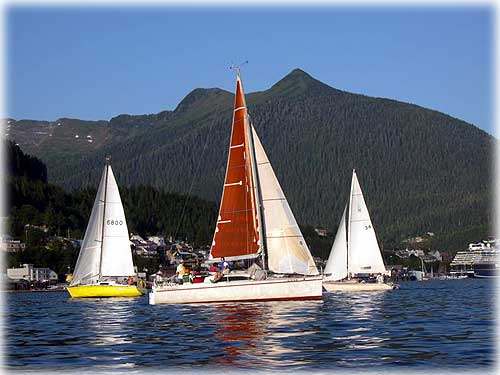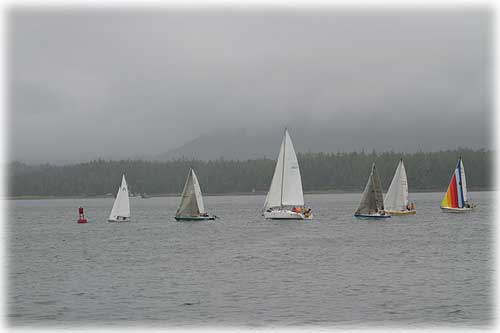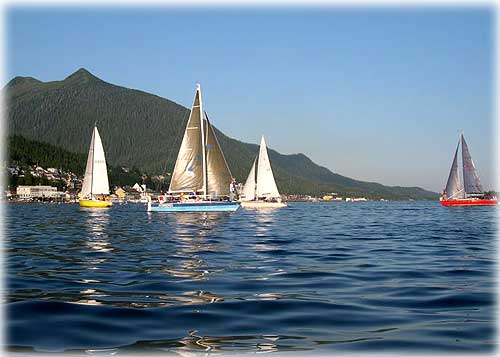 By Mary Lynne Dahl, crew on the Spirit, KYC Racing Fleet July 27, 2004
 Photograph by Jim Dahl©2004 The races run from early April to the end of September and are sponsored by the members of Ketchikan Yacht Club, home based in Thomas Basin Harbor. Weekly races begin at 6:00 pm on Wednesday, but there are 5 or 6 weekend races during the summer as well, usually starting on a Saturday. In addition, there is a 5-day regatta every August. This regatta, called KORC (Ketchikan Ocean Racing Circuit), is a fundraiser that for over 20 years has raised thousands of dollars for charity, all from donations and fees paid by the racing skippers and their crews. Wednesday night racing starts at 6:00 pm with a warning horn of several blasts from the committee boat, which is anchored between the shore and the red buoy known as WR6, just off of the Safeway Store. The purpose of the warning blasts are to get the attention of the racing sailors, to tell them that the race will begin in earnest in 30 seconds with a 10 minute countdown. When 30 seconds has passed, the start horn sounds and a white flag is raised. The race is now underway, and the boats will begin to come closer to the starting line, the distance between the committee boat and WR6, by sailing back and forth, avoiding collisions, taking note of the wind and currents, jockeying for the best starting position and adhering to a complex set of racing rules. Often during this 10 minute start sequence, boats will raise sails, change sails and make a series of practice starts, to make themselves ready for crossing the start line when the horn finally sounds at the end of the 10 minute countdown. Five minutes prior to the starting countdown, all boats are required to shut down their engines, even if they require them to get to the starting line on time, so a boat that is late getting away from the dock risks being late getting to the start line in time. At the end of the 10 minute countdown, the committee boat sounds the starting horn and raises the starting flag, and the race is on! At this point, each boat will attempt to get the best start by crossing the line in the best spot she can find. From the shore, this can look pretty much like a wild conflagration, boats coming so close to each other that they sometimes appear to nearly collide. Once in a while they do, in fact, collide, which is a serious breach of racing rules. More on rules in the next article in this sailboat racing series of articles.  Photograph courtesy Mary Lynn Dahl Now that the race is underway, viewers may notice a couple of boats heading one direction while the rest are heading the exact opposite direction, and wonder where they are going, why they separate and what advantages they think they are gaining by doing so. That's a great question, and gets to the heart of racing a sailboat, especially in a harbor such as ours here in Ketchikan. The answer is that each boat, with a different size, waterline, sails, keel and weight, is looking just the right conditions to use to create the most speed and direct route to the turning mark. The committee boat has posted the numbers of the course being called for that race, on the side of the committee boat facing the racers. These course numbers are generally not visible from the shore side of town, so viewers rarely see them, but the racers do. The pre-determined course instructs the racing boats where to head, which buoys or marks to use for turning, and how many turning marks are in the course that has been called. So, each boat will seek what they hope will be the fastest, most direct route to each turning mark, then back across the start line to finish, making the it the start-finish line, in fact. In the Ketchikan Yacht Club racing fleet, most of the boats are individual and different. It is not what is referred to as a "one design fleet", meaning that it is not a fleet made up of a number of boats of the same size and design. Because of the differences between boats as a result of this variety of boats that race, some boats are naturally able to go faster than others, so the racing rules allow for a system of handicapping that provides an incentive for a slower boat to race and perhaps win. This system is known as the PHRF (Performance Handicap Rating Formula) system. In theory, the PHRF system used in Ketchikan rates each boat with a "go fast number" that assumes that the boat is being raced in optimum condition, in medium winds with optimum skills on the part of the skipper and crew. The faster the boat under these assumptions, the lower the PHRF rating, so the faster boats must give time to the slower boats, which gives the slower boats a chance to obtain better scores and a shot at winning. A boat that crosses the line first may not, in fact, be the winner, as a slower boat crossing second or third may, by virtue of her higher handicap, "correct over" the faster boat and be awarded the first place for that race. All of the boats, regardless of their handicaps, however, report that it is a thrill to be the first to cross the finish line, even if they don't get the first place award due to PHRF handicapping.  Photograph by Jim Dahl©2004
Generally, the races begin by heading into the wind rather than downwind. That means that the boats head up, towards the mark, in wind that is coming across the forward portion of the boats. During these upwind legs of the race, the boats will use the sails known as the main sail and the jib, or fore sail. On most boats, the helmsperson will make the tactical decisions and drive the boat in whatever direction it should go. In addition, each boat has a crew person in charge of each sail. Their job is to "trim" their sails during the race, for maximum speed and efficiency. Trimming a sail requires that the trimmer be aware of the wind and adjust the lines that hold the sail in place by letting line out or bringing line in tighter. In light winds, the trimmer generally tends to loosen his or her trim on a sail, tightening up in heavier winds. In smaller boats, a helmsperson may double up as a trimmer when necessary, but on the larger boats this is often a separate job entirely. Once the boats reach a turning mark and head the other direction, they will change the fore sail by hoisting the spinnaker. Viewers report often that the part of the racing that they enjoy the most is watching the boats fly their colorful spinnakers, referred to often as "chutes". Spinnakers are head sails that fly loosely out in front, catching the wind as it comes from behind the boat. They are capable of making the boat go faster than it would under the upwind head sail (the jib) and they require a different set of skills to hoist, turn with and take down. Spinnaker work on a racing sailboat is divided into specialty skills that each crew member exercises in every race. Being successful at the spinnaker can make or break a race for any boat and is considered an important component in the goal of winning, every time. A spinnaker is flown from a pole attached to the mast, with lines on each corner of the sail, puffed up with the wind (hopefully) and flying beautifully out in front of the sailboat as it heads for the next mark. It is a sight to see, often colorful and graceful, especially if the boats are fairly close, side-by-side or in a lineup as they sail. In Ketchikan, photo opportunities abound for outstanding shots of sailboats heading into the Southeast sunset with colorful spinnakers flying. It is part of the pleasure of living in Ketchikan, a unique place with some of the best sailing, racing and accomplished racing sailors in Alaska.
Future Articles: names of Ketchikan boats, racing rules, technical terms and opportunities for the public to join in the fun.
|